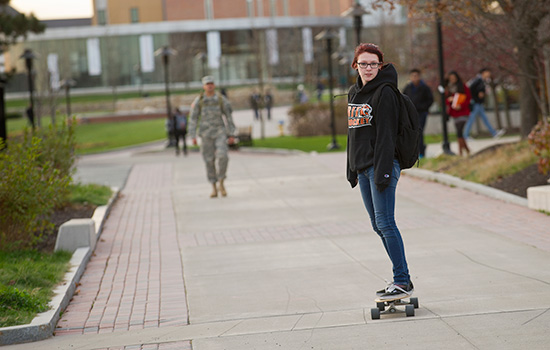Longboarding rolls into campus life
A. Sue Weisler
Despite the many falls, bruises and ripped jeans Emily Himmelwright got when first learning to longboard at RIT, it has become a favorite hobby of hers.
Emily Himmelwright can make it from her dorm room to the academic side of campus in five minutes if she rides her longboard, saving her more than 10 minutes if she were to walk to class instead.
Longboarding has taken off at RIT and college campuses nationwide as a cool, and efficient, form of transportation. “The college longboarding community is growing,” said Aaron Costa, owner of the Rochester skate shop Krudco.
Krudco has been selling longboards, which are longer and wider than a traditional skateboard and made out of maple wood, since 1995. Over the past five years, Costa said that longboarding sales and inquires at his shop have tripled.
He attributes the increase to how easy it is to get around on a longboard and the lack of pressure to do tricks that often comes with skateboarding. The biggest advantage over a skateboard is the bigger, softer wheels, which make it smoother when going over bumps, cracks and the characteristic RIT bricks.
RIT’s longboarding community has become one of the largest in the Rochester area because of the flat, sprawling campus, students say.
There is no official longboarding club at RIT; instead, a Facebook group, Skate[roc] @ RIT, serves as a forum for longboarders on campus. The group, which has almost 170 members, uses the Facebook page to post where they will be skating and boards or equipment they are selling.
When the weather is nice, more than 20 longboarders from RIT’s deaf and hard-of-hearing community also get together for a weekly cruise around campus.
For Andrew Goodsell, a fifth-year mechanical engineering technology student from Oneida, N.Y., longboarding has become a large part of his college experience. He had been involved in skateboarding before college but didn’t buy his first longboard until he came to RIT. A friend he met in one of his classes longboarded and showed Goodsell where he could buy his first board and the best places to skate on campus.
Now, he helps set up longboarding events in Rochester and is a team rider for locally based longboarding company Enraged Panda.
“My favorite thing about the longboarding community is that when you see someone else with a longboard, you can instantly go up and have a conversation with them,” Goodsell said. “It’s a very friendly community.”
Himmelwright, a second-year media arts and technology student from Schenectady, N.Y., didn’t start longboarding until her freshman year at RIT. She has since purchased two boards and met many friends through the longboarding community on campus.
“I probably skate about three hours a day if it’s really nice out,” Himmelwright said.
Generally, Himmelwright has gotten good reactions from teachers and administrators when she brings her longboard to class. It’s not uncommon to see longboards lined up next to desks or in the back of classrooms.
“There are a lot of good places to put a longboard, especially in a big lecture hall,” she said. “I have even had a presenter ask if she could try using my longboard.”
Bumps and bruises
The increase in longboarding on campus has had an impact on pedestrian traffic patterns and the nature of injuries seen at the Student Health Center.
Public Safety uses signs and sandwich boards to remind students to use the bike path, not the pedestrian-heavy Quarter Mile, when longboarding, skateboarding or biking.
“Students are generally always respectful and compliant,” said Chris Denninger, director of Public Safety. “The signs, sandwich boards and scheduled patrols are all about awareness and educating students on why it is a safety issue for them to ride on the Quarter Mile.”
Last year, Missy Maschoff, a nurse at the Student Health Center, treated only a few longboarding injuries at the beginning of the year. This school year, she sees an average of eight to 10 students with a longboarding-related incident each week, ranging from scrapes and bruises to wrist and ankle fractures and concussions.
Learn More:














